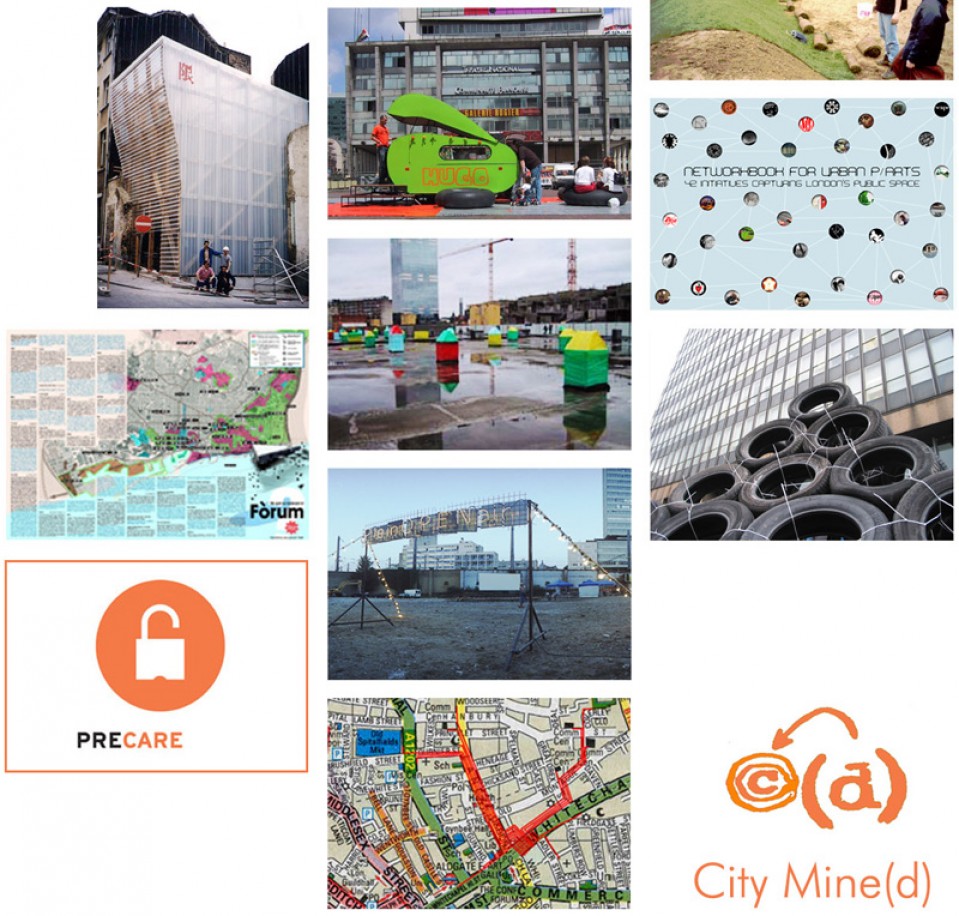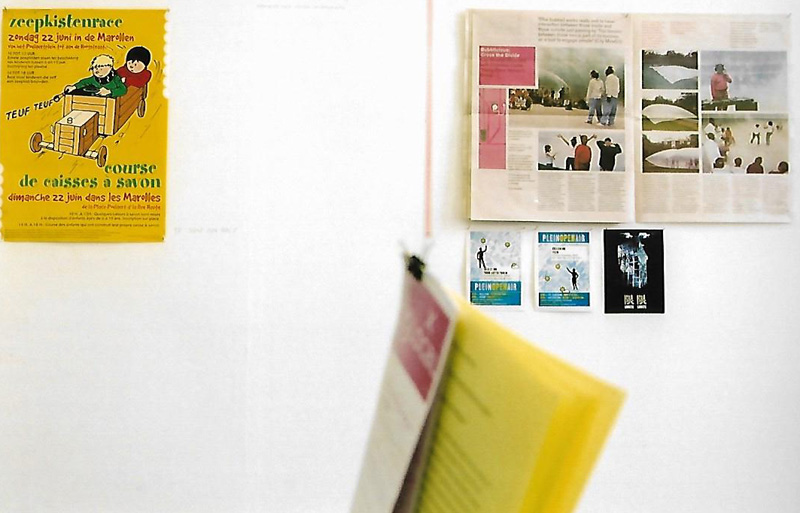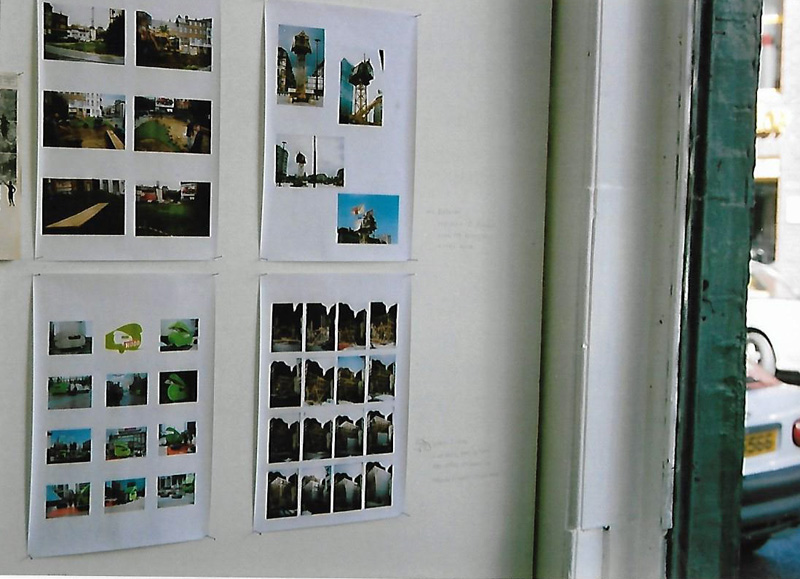
Opening
26 August, 6-8pm
Talk
Sat 28 August, 6pm
City Mine(d)
Urban interventions
city mine(d) team
Ends 09 September 2004
urban interventions by the Belgium group City
MIne(d) is the first in a sequence of
projects in PS² addressing themes of urban creativity in an
open, socially integrative way, challenging existing positions in public
art.
The exhibition will
document the group’s work to date in film and projection, including a temporary
performance venue for Catalyst Arts Belfast to be realized in December.
Within this context City Mine(d)’s diverse creativity and socially inclusive projects and support network will challenge existing positions of public art.
About City Mine(d)
City Mine(d)- founded in 1997 in Brussels by people with various creative backgrounds- expanded 2003 to London and Barcelona.The group’s main work is the creation of interventions in public spaces with the involvement of the community, integrating individuals and groups from socially different backgrounds.
Their projects, ranging from large structures (landmark building, Brussels 1997) to small tyre sculptures (Sheffield 2002), are a creative response to re-appropriate public space in an artful and inclusive way, encouraging new forms of urban citizenship within a local and international (Brussels-Belfast) context. City Mine(d) actively supports urban interventions elsewhere and disseminates their knowledge through booklets, web sites and teaching projects at universities.

Installation view
About [reLimite]
Summery
[reLimite]
wants to be a symbol of change in Brussels and Belfast, and
a catalyst to bring together disparate groups within and between those two
cities.
It
will do so by combing the emblematic character, physical material and
methodology of a previous project in Brussels with newly forged connections in
Belfast and between Brussels and Belfast.
The physical result will be a temporary structure that can be re-used as a venue on other sites; the non-material result will be a local partnership involving private and public partners from different scales in the city: from the very local –residents, shopkeepers and municipal authorities- to the global –international corporations, arts and cultural institutions, in which the partners mutually benefit from each others ambitions.
The
project will start of in the Brussels commune of Schaarbeek with the breaking
of the previous project, jointly by a local and Belfast apprenticeship
training, and with the recuperated parts a temporary venue will be built in the
heart of Belfast.
Partners
involved are: apprenticeship training APAJ classe chantier, British Council
Belfast, Catalyst Arts City Mine(d), architect Chris Rossaert,
LimiteLimitevzw, Ulster University
School of Architecture, …
The
following document explains the project [reLimite] in more detail. After a
general description of the projects aims (I), it provides a description of the
characteristics of the project (II), how
it should be perceived (III), an operational timetable (IV), the organization
behind (V) and the financial plan (VI).
I. General description
[reLimite (rLt)] involves the breaking up of a nine metre
high landmark construction in Brussels, and the combination of its parts into a
new structure for Belfast. The new structure will be devised in such a way that
it is easy to dismantle, to move to another site and be reassembled there. The
new structure will accommodate an arts festival in Belfast, and after that will
continue its journey to other locations in other cities
Because of the involvement of individuals from very distinct groups in the city, including a global investment bank, high schools, local shopkeepers, an apprenticeship training and an architect, the project in Brussels evolved from the creation of a work of art into an experiment in urban governance. The method has been acknowledged as a successful form of social and urban innovation in a range of publications. The partnership that emerged from this collaboration, formalised in an organization called LimiteLimite, has the ambition to add a new dimension to its endeavour, and wants to use method and materials from the building they constructed to forge inter-city connections
[ReLimite] aims at contributing to new forms of urban citizenship by combining the empowering qualities of culture with dynamic alliances and collaborations.
It does so by creating
- a symbol for an area, a sign that something can happen, and as
- a catalyst for bringing together disparate groups.
[ReLimite] is not so much about replicating a model, as it is about pushing the method one step further by including in its network the intercity connections that inform contemporary city life.
II. Realization
1. “Castle to BT1”
[reLimite] consists of two distinct stages, the first one
in Brussels, the second one in Belfast, both of which involve the same groups
of builders, artists, urban dwellers and those who regulate city life. In each
city the project also wants to engage the local community and grip the
attention of passer-by.

Installation view
The Brussels side
The
Brussels side will happen in late spring 2004. With the help of architect Chris
Rossaert, apprenticeship training APAJ- Classe Chantier, who together built the
construction in 1999, will dismantle the tower, and will make an inventory of
the pieces that can still be of use in a new construction.
The construction consists of wooden girders and corrugated
plastic sheets. Its design was such to make it the new lighthouse for the are:
a nine-meter high construction that protrudes into the street, to attract
attention, and that is made up of synthetic corrugated sheet in order to be
transparent on one side, and translucent on the other. The structure consists of a framework of
wooden girders on which PVC-plates were attached. Light inside makes the
building a reference during the night.
During the time of the dismantling, which is anticipated to take about 3 weeks, a shipping container will be positioned on the building site. This will not only serve as storage space for pieces and equipment; its outside will also be used as a way to communicate with the local community. In drawings and text passers-by will be kept updated on the state and future plans of [reLimite].
The
shipping container will also serve its proper function of shipping the pieces
from Brussels to Belfast.
The Belfast side
In Belfast, a new construction will be designed by students of the Ulster University School of Architecture, under supervision of local architects. They will receive the inventory of pieces in the early summer, and will be asked to combine according to a brief drawn up jointly by Catalyst Arts, a Belfast Artists Collective, and City Mine(d), Brussels production house and the British Council Belfast.
The temporary structure will serve as the venue for FIX, the performance festival Catalyst Arts organised in Belfast in December 2004. The location for this new temporary structure will be chosen together by the architects, Catalyst arts, City Mine(d) and local partners.
The
Belfast side of the project will start off in the summer, with the arrival of
the shipping container with the pieces. Although building will only start a few
months later, the container will in this case also serve as a means to
communicate to the public. When it arrives, it will contain messages from Brussels;
local groups will be asked to paint their own messages on it, and as was the
case in Brussels, text will be used to communicate the state of affairs of the
project.
The Third side
After having served its purpose of accommodating FIX, the demountable structure will be used for inscribing other localities in its network, and contribute to a new image for these places.
2. Communication
The
public will be involved in three ways: as a participant, as passer-by, and
through different media.
Partcipants will be brought together in a Partnership
[reLimite]. At the start it will consist of the architects, the builders,
Catalyst Arts, City Mine(d) and the organization LimiteLimite, but during the
course of the project other can also join (local communities, local
authorities, …)
A shipping container will function as a first expression of what is to come. It will display written and graphic information explaining what is to come and the status of the project, and will capture the imagination of people in Brussels and later in Belfast. Besides that, people will be informed in advance through posters, flyers, mailings, and websites and through cultural calendars. Local press will be involved in an early stage of the preparation.
Press coverage and an update of events on the website www.citymined.org. inform people who are not directly involved in the project. At the end results, knowledge and experiences will be published. The whole process will be recorded and made into a short film by Polymorfilms, a Brussels filmmakers collective.
III. Situation
[reLimite] is an arts project consisting of
- -the construction of a temporary venue
- -the opportunity for young designers to be bold in their work
- -the opportunity for apprentices to learn their profession with an eye-catching work
- -the creation of a partnership that empowers individuals with very different backgrounds to have an effect on the development of their city
- -the forging of connections between Brussels and Belfast that would contribute to partnerships in terms of recognition, skills and experience.
[reLimite] is the sequal to LimiteLimite, a project that in Brussels was successful in meeting its initial four targets: to solve the nuisance of a residual space that had become a waste dump; to create a visual and positive landmark in the deprived neighbourhood; to promote the conviviality between at the one hand the different groups living in the Brabantwijk and at the other hand the groups who attend the neighbourhood-such as commuters, shoppers, employees and the approximately 3000 students, to advance an effective, inclusive partnership prone to clear the current stalemate situation that cornered the neighbourhood.
The project attracted private funding as it combined a strategy of inclusiveness with a more market-style tactic to promote a new image for the neighbourhood. Nevertheless, in a second stage LimiteLimite made connections with government bodies at different scale levels: the partnership of LimiteLimite still exist and is funded by the Stedenfonds; today the organization benefits of a good relation with the municipality; LimiteLimite became a partner of an agreement between the municipality and local partners with the regional government to regenerate the neighbourhood; it received the “Thuis in de stad”-prijs of the Flemish Community as the best practice of local development; the project is perceived as one of the main reasons why the neighbourhood attracted, the European funding program, Urban.
Today the partnership is formalized into a non-profit association. They continue to pursue the objectives of LimiteLimite. The organization has a professional staff and a board that consists the members of the partnership generated by the project.
The methodology of [reLimite] is not a bottom to up-, or a top-down process. It mobilizes in each step two scales simultaneously. For example it involved a local apprenticeship training and a high school catering to the whole country, or a global investment bank and local shopkeepers, or municipal, regional and national government.
IV Operation
November 2003-april 2004 development of concept and partnership
Purchase shipping container
The Brussels side
1 April start reLimite
*The empty shipping container will be placed on the site, arts school students from a school in the area express the message “LimiteLimite is going to Belfast” on the side of the container, the local community is informed about the project
*Filmcrew: starts recording operations
19 April start salvage operation
*A Brussels and Belfast apprencticeship training start breaking up the construction.
*To inform the community, the organization LimiteLimite organizes breakfast on site
*During the project the shipping container will be used as a blackboard for messages on the project
25 April deadline salvage operation
Container stays on site and remains a means of communication
15 May Community get together
Shipping container leaves the area
Press-conference to announce the Belfast side
Between 15 may-1 September transport of shipping container to Belfast
The Belfast side
1 September concept
Architects and students develop a concept for a construction, and test it with a structural engineer
Shipping container put on site and used as a means of communication about the Brussels side and future plans
1 November building
Apprenticeship training from Belfast and Brussels start building the construction
Catalyst Arts involved in communication to the local community and in the creation of Fix
1 December inauguration
Press conference presenting the construction and FIX
December
Fix festival: use of the construction
End
December: salvage for next use
V Organization
Limite limite vzw: legal owner of the construction, responsible for its demolition
Apaj asbl: Atelier Formation de Travaille, apprenticeship training who built the construction and will be charged with its breaking up. They are situatied in the area, work with mixed groups of men and women in the building sector, and are very open to an exchange with a Belfast organization.
City Mine(d) vzw: production house with its main office in Brussels, and with an office in London, initiates the project along with the British Council Belfast and will, as in Limite Limite function as the executive producer of [reLimite].
Belfast apprenticeship training
Chris Rossaert: architect in charge of operations during the first construction, will contribute his expertise to this new stage
Belfast Architect
Ulster University school of Architecture: architecture students will be involved in developing a new concept for a construction
British Council Belfast: co-initiator and co-producer along with City Mine(d)
Arts Catalysts: arts collective from Belfast, who biannually organise the performance festival FIX, and who are attuning their agenda to that of [reLimite]
Relevant publications
Stefano Boeri, Multiplicity, Arc en rêve centre d’Architecture (2000), « Mutations », Bordeaux (FR), Actar
St Lukasarchief (2000), « Recycling is another chance » an architectural exhibition CD-Rom presented by Sint Lukasarchief, Brussels (B), Sint-Lukasarchief
Hannah Ford and Bridget Sawyers (2003), « International Architecture Centres, a critical guide » London (UK) Wiley Europe
Ruth Morrow (2003), « Building Clouds Drifting Walls » Sheffield (UK) University of Sheffield School of Architecture,
Thuis in de Stad (2003), « Witboek Stedenbeleid », Brussel (B), Ministerie van de Vlaamse Gemeenschap
Alberto Lacovoni (2004), « Gamezone, Playgrounds between virtual
scenarios and reality», Basel (CH), Birkhaüser
La Cambre/La
lettre (2004) « Le Livre blanc de l’architecture en Communauté
française de Belgique », Brussel (B), La Cambre
City Mine(d) (2004) « Networkbook
for Urban P/arts », London (UK),
City Mine(d)
Raffaele Paloscia, Inura (2004) « The Contested Metropolis » Basel (CH) Birkhäuser

